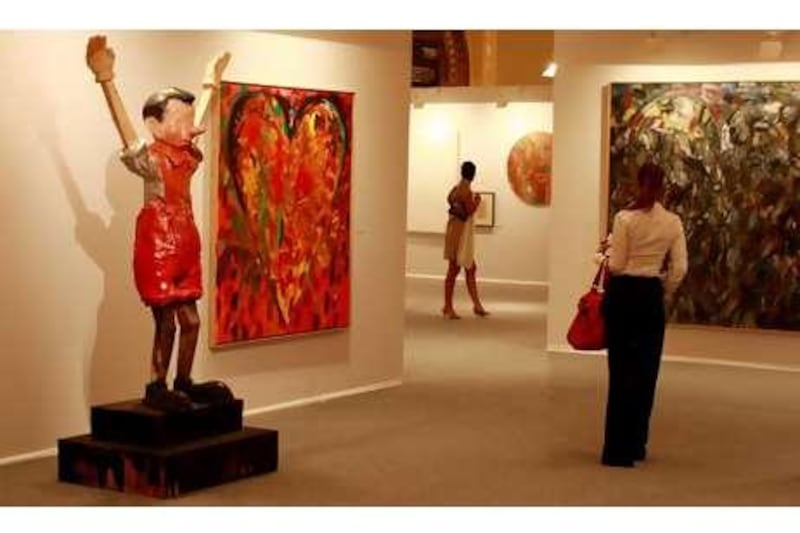ABU DHABI // The capital's ambitious vision to become the cultural heart of the region was outlined yesterday to 100 of the world's most prominent artists, collectors and curators. Dr Zaki Nusseibeh, the deputy chairman of the Abu Dhabi Authority for Culture and Heritage, told of the treasure halls that would be housed on Abu Dhabi's US$27 billion (Dh98.5bn) Saadiyat Island, describing it as the "crown jewel of the Emirates". His talk at the Emirates Palace hotel was part of a three-day programme for specialists aimed at bridging the western and Middle Eastern art worlds and raising the profile of Abu Dhabi's culture and art projects internationally.
When Dr Nusseibeh, an adviser at the Ministry of Presidential Affairs, had finished, the group was taken on a helicopter tour of the site, which will be home to the Abu Dhabi Louvre and Guggenheim. "It's hard to believe that all this is happening here. The cultural impact on the whole region will be massive," said Reza Derakshani, an Iranian artist and musician, who is exhibiting at artparis-Abu Dhabi, a showcase of contemporary modern art launched yesterday.
He did not doubt Abu Dhabi's ability to become an international centre for art but said it should focus on carving out a niche for itself, rather than competing with more established cities. "It takes time - and, of course, to compete with New York and London as a centre for art, that's different. Abu Dhabi needs to be something of its own. I'm sure because of the identity of the region and the cultural heritage it could become unique in its own way.
"If there's a will behind it to make an impact it will happen." The development on Saadiyat Island, which is expected to be completed by 2018, will house museums and concert halls designed by world-renowned architects such as Frank Gehry and Jean Nouvel. It lies half a kilometre off Abu Dhabi and covers 27 square kilometres. Parviz Tanavoli, an Iranian sculptor based in Vancouver, Canada, said he was impressed with Abu Dhabi's commitment to developing the arts, and wanted to become more involved.
"I had some idea about the projects here but I've learnt a lot more. We just had some scattered news but had no idea about the extent of what is happening. At the moment I have no part in this Abu Dhabi project but in the future I would like to be involved, especially in regard to contemporary art." Dr Nusseibeh highlighted Abu Dhabi's projects across the fields of art and culture, including the Middle East International Film Festival, Abu Dhabi Classics season and the Kalima translation project. He also stressed the importance of preserving the emirate's natural heritage and values amid large-scale development.
"Forty years ago it would have been inconceivable for me to come before such distinguished company to talk about Abu Dhabi's cultural vision," he said. "Today we are no longer merely one of the largest gas and oil producers in the world, but also a financial and economic powerhouse trying to create the future heritage of our country. We are embarking on a unique journey, balancing our rich and ancient heritage as an Arab and Islamic country with a global cultural outlook that embraces the world."
It is hoped the event, which began on Sunday, will demonstrate the emirate's commitment to support artists and collectors. Julia Peyton-Jones, the director of the Serpentine Gallery, in London, Aaron Betsky, the director of the Cincinnati Art Museum, and Hans Ulrich Obrist, the Swiss curator and art critic, are among those attending. Today the group will view the Royal Family's private art collection at the Sea Palace, the residence of Sheikh Mohammed bin Zayed, Crown Prince of Abu Dhabi.
lmorris@thenational.ae






